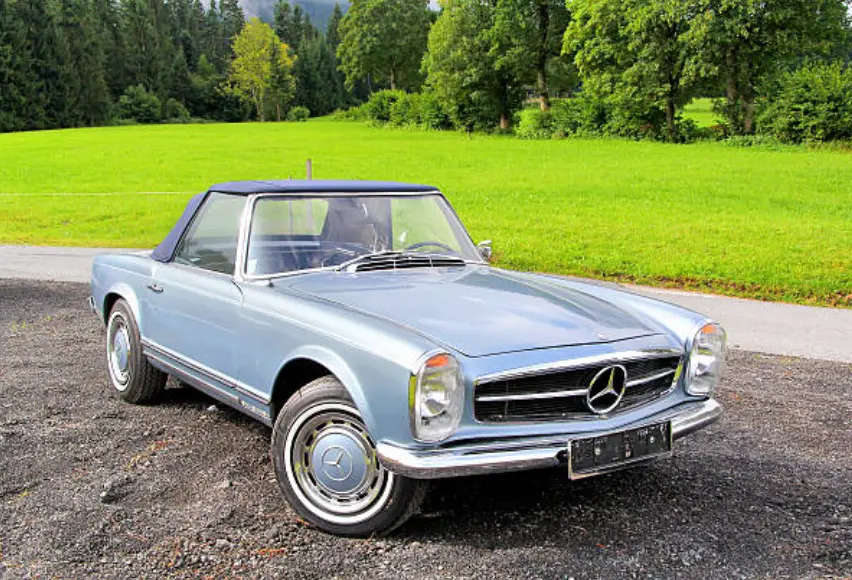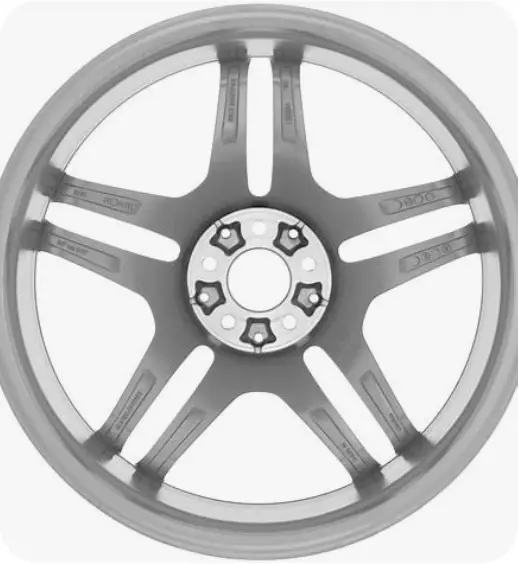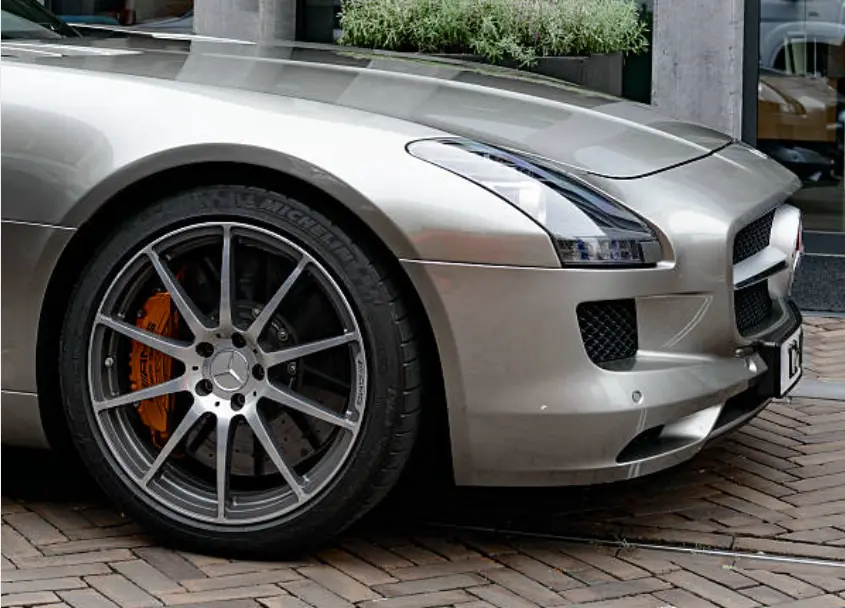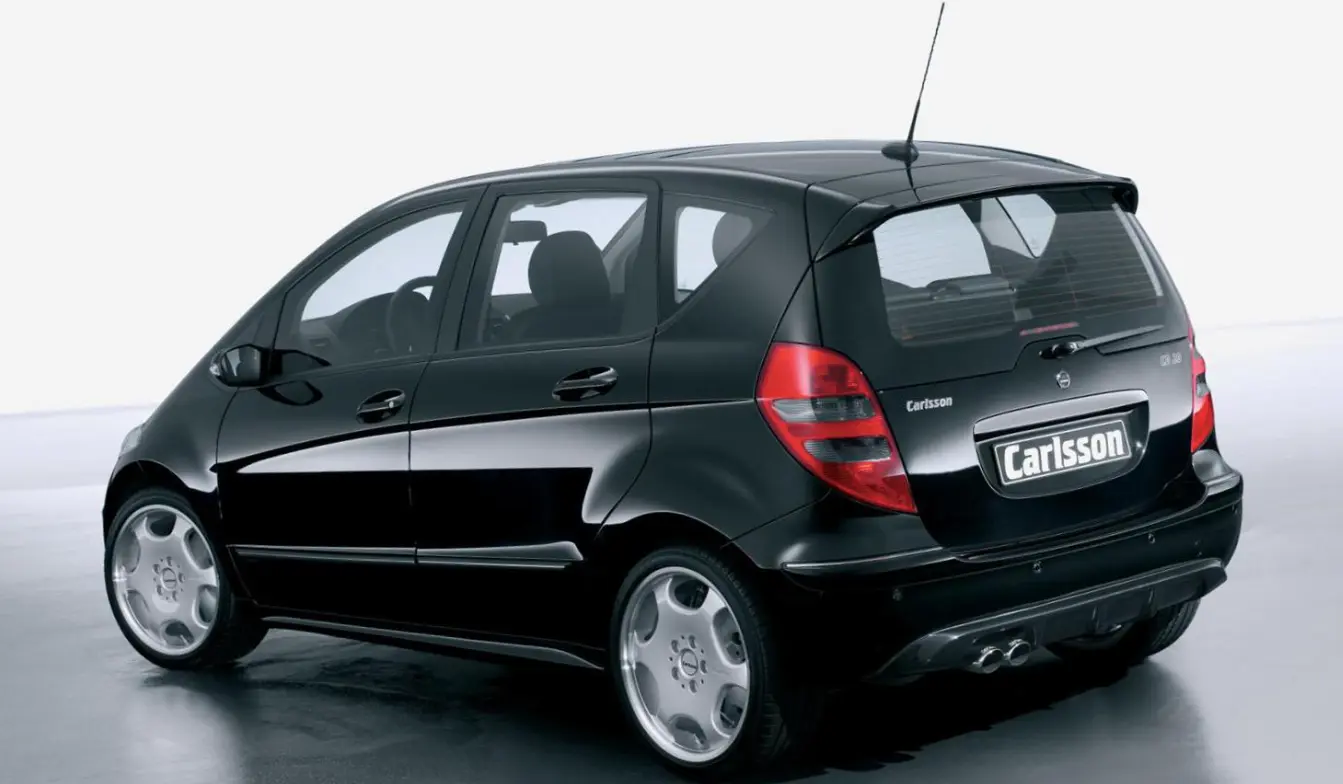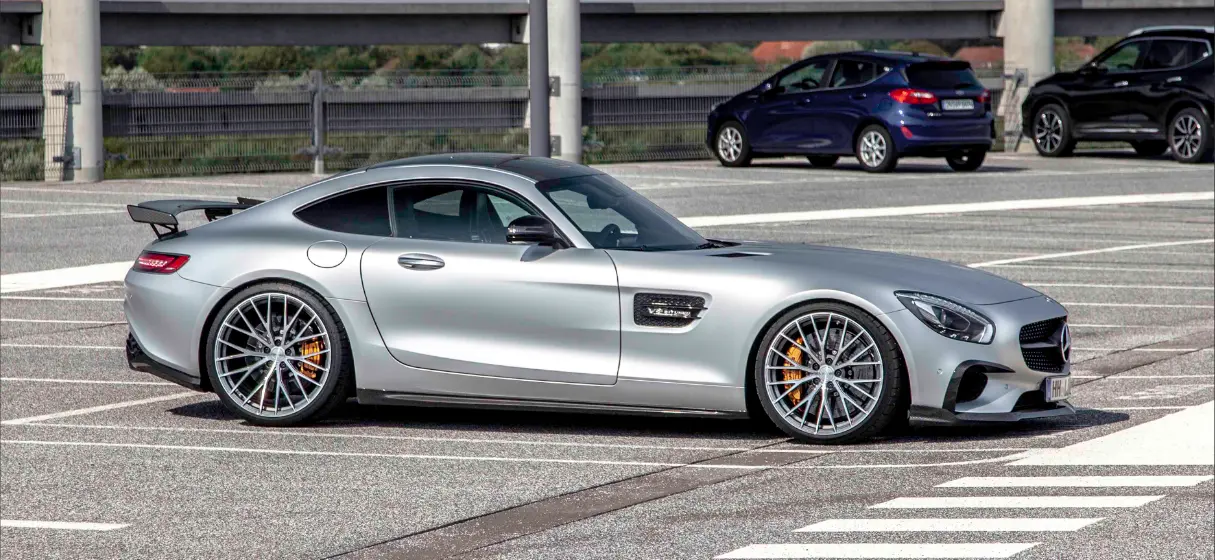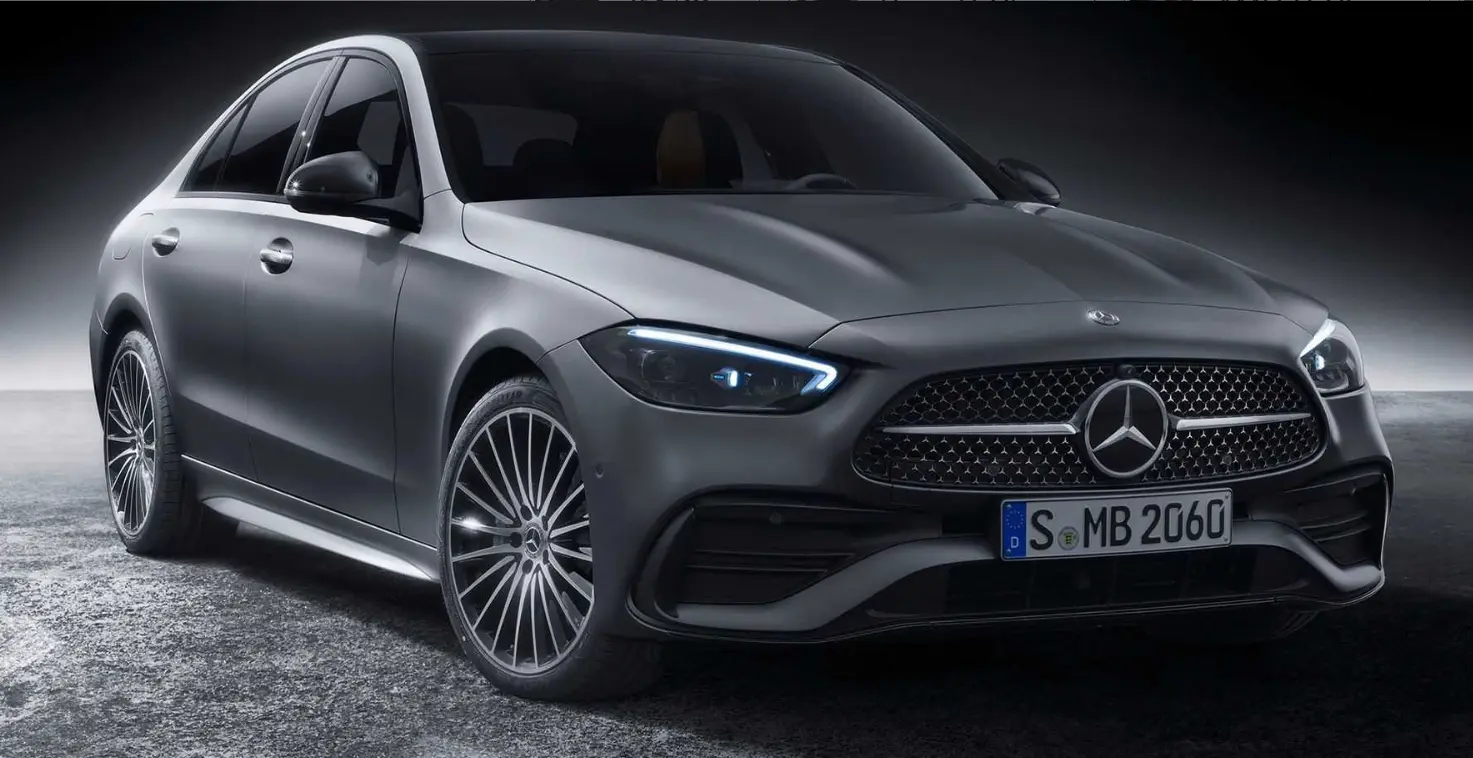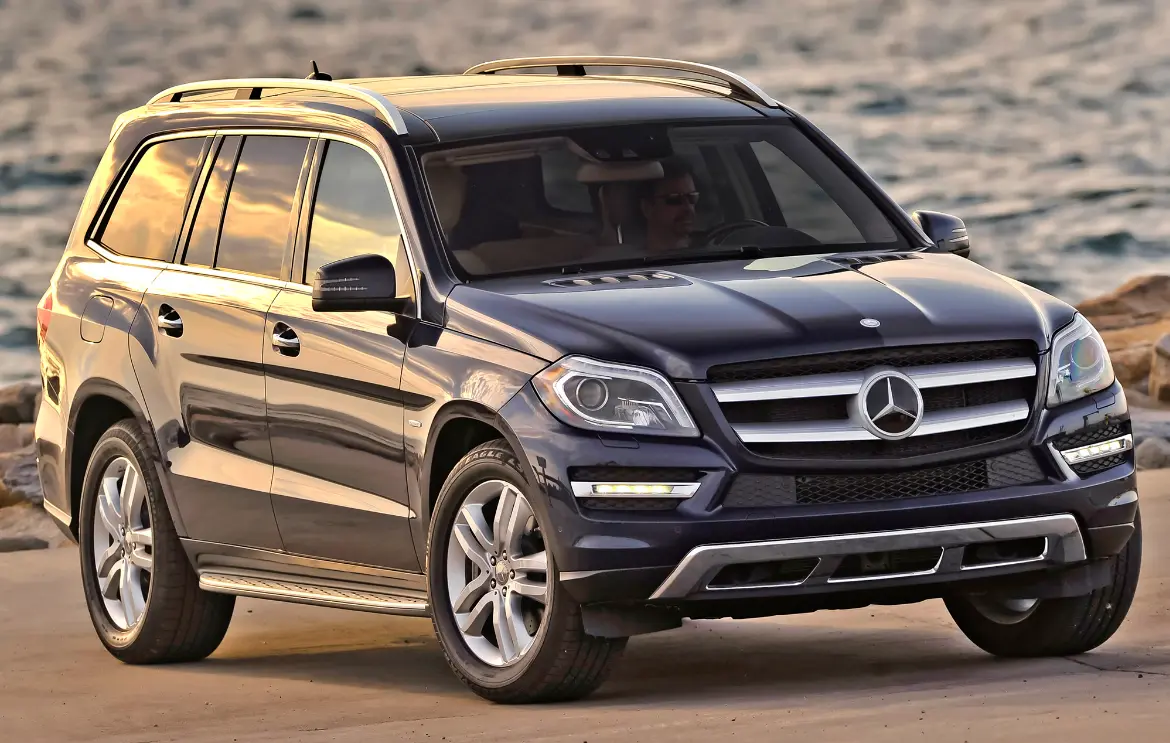Mercedes-Benz cars are famous for their sophisticated appearance with the wheels playing a key role in achieving this stylish look. The company’s commitment to innovation can be seen in the rim styles it has introduced over time. This article will delve into the background of Mercedes Benz rims, and how they have evolved. It will also provide tips for maintaining them and exploring aftermarket choices available.
Mercedes-Benz Rims Through the Decades
Old Style Wheels
Between 1969 and 1985, Maserati introduced their Classic Style wheels. These rims incorporated improvements in wheel technology resulting in a weight compared to prior models without sacrificing durability. Some individuals describe their design as “Baroque” while others nickname them “Ring-shaped cake” wheels due to their resemblance to a Bundt cake.
5-Spoke and Twin Spoke Wheels
The next big development came with the introduction of the 5 spoke wheel in 2000 as part of the “Style III” series of rims, which paved the way for the popular “Style IV,” also known as Twin Spoke rims, that hit the market around that period as well. Since then, Mercedes has been consistently creating designs for wheels, and today there are a variety of choices available for drivers.
Rim Maintenance
To preserve the appearance and durability of your Mercedes, it’s crucial to care for its rims and maintain their pristine luxury look over time. Here are some top tips for maintaining the rims of your Mercedes in condition:
Cleaning Your Rims
- Use the right tools: Use a soft brush, a wheel-specific cleaner, and a bucket of soapy water.
- Rinse thoroughly: After cleaning, make sure to rinse off all soap residue.
- Dry the rims: Use a washcloth to wipe off any remaining residue.
- Apply sealant: Many people use wax or another type of sealant on their wheels to maintain their clean look.
Mercedes Wheel Compatibility
Before purchasing wheels for your Mercedes vehicle and making a decision on the best rims to go for, it’s important to check the compatibility with your specific model of Mercedes car first and foremost. The compatibility of the wheel entails elements including rim size, bolt pattern, and offset. Ensuring that these aspects are in line will not only guarantee a proper fit but also enhance overall performance. While most Mercedes Benz cars typically utilize a 5 x 112 bolt pattern providing some flexibility when swapping out wheels, it’s crucial to take into account factors like rim width, diameter, and offset before proceeding with any changes.
Choosing Mercedes Rims
When choosing rims for your Mercedes car model, choice should take into account both the appeal and practical use of the rims.
OEM Mercedes Wheels
Mercedes OEM wheels guarantee compatibility and reliability, as they are custom-designed for your vehicle to ensure fit and performance.
Aftermarket Mercedes Rims
When it comes to aftermarket Mercedes wheels and rims, the selection offers a range of styles and finishes that allow for personalization and potentially more competitive pricing options. To consider are the bolt pattern and width of the rim when looking at aftermarket choices; remember that brands like Adsitco offer a variety of aftermarket versions of traditional rims in different sizes and finishes.
Mercedes Rim Upgrades
Boosting the style and capabilities of your Mercedes through upgrading the rims can make a difference in how your vehicle looks and performs better too! When thinking about upgrading your rims for handling and speed enhancement, consider going for performance-oriented options like the Mercedes Benz AMG wheels, which are renowned for their durability and sleek design. Ideal for those aiming for top-notch performance upgrades! Remember to check that any upgrades you opt for are in line with Mercedes’ guidelines regarding wheel compatibility to ensure a smooth ride ahead!
Mercedes Wheel Care
Taking care of your wheels goes beyond simply cleaning them regularly. It also means looking out for alignment problems, maintaining tire pressure, and using suitable products to protect the gloss or matte appearance. For a maintenance routine, you can consider services such as Mercedes Benz’s Wheel and Tire Protection plans or seek advice from authorized experts.
Style with Mercedes-Benz Wheels
Looking to stand out? Mercedes Benz-style wheels with a chrome finish can give your car that extra flair and boost its overall appearance! These wheels not only look great but also deliver top-notch performance—a favorite pick for car enthusiasts wanting to add a personal touch to their ride.
Wheel Manufacturing Processes
When looking at new wheels to purchase, it’s important to know about the various ways they are made. The main methods used in manufacturing include:
Cast Wheels
Creating a cast wheel involves pouring melted aluminum into a mold to cool and form its shape swiftly and affordably for the production of economical wheels; however, this process may result in porous spots that weaken the structure, prompting manufacturers to allow for larger tolerances and therefore increasing the weight of the wheel.
Forged Wheels
Custom wheels are crafted by subjecting a chunk of aluminum or other metals to high temperatures and pressure to create forged wheels that are denser and sturdier than cast ones while being lighter due to their enhanced strength properties that require less material usage in the manufacturing process. Forged wheels usually utilize aerospace grade 6061 T6 forged aluminum alloys known for delivering mechanical characteristics preferred by engineers. Despite its advantages, the forging process is known for its increased complexity demand, resources, and higher costs compared to casting methods. Forged wheels are considered the pinnacle in aftermarket wheels.
Flow Form Wheels
Flow form wheels or flow forged wheels serve as an option bridging the characteristics of cast and forged wheels in the automotive industry. The production technique involves creating a cast wheel with a narrower width than required and then subjecting it to a machining process where steel rollers compress and stretch the barrel to enhance its strength and reduce weight. Flow forming represents a cost solution that delivers improved performance, in comparison to cast wheels without the added expense of fully forged ones.
Hybrid Forged Wheels
Hybrid forged wheels bring together the techniques of low-pressure casting and rotary forging for their production process. Initially shaping a metal piece through casting and then refining it through forging involves spinning the metal quickly under pressure to achieve the desired strength and shape. This method merges the advantages of both casting and forging methods to create wheels that are durable yet light in weight, with a precise final form compared to those crafted using casting or flow-forming approaches.
Advantages and Disadvantages of Different Wheel Types
| Wheel Type | Manufacturing Process | Strength | Weight | Cost | Durability | Performance |
| Cast Wheels | Molten aluminum poured into a mold | Lower | Higher | Lower | Lower | Lower |
| Forged Wheels | Extreme heat and pressure applied to a solid metal block | Higher | Lower | Higher | Higher | Higher |
| Flow Form Wheels | Start with a cast wheel, then compress and stretch the barrel | Moderate | Moderate | Moderate | Moderate | Moderate |
| Hybrid Forged Wheels | Combination of low-pressure casting with rotary forging | Moderate to High | Moderate | Moderate to High | Moderate to High | Moderate to High |
The Importance of Wheel Runout
The precision of a wheel’s manufacturing quality is often determined by its wheel runout measurement, which reflects the roundness of the object; a lower value signifies a perfectly rounded circle shape. Excessive wheel runout can lead to vibrations felt through the steering wheel at speeds and pose potential safety risks. In an attempt to cut costs without compromising safety or comfort levels during driving experiences, some manufacturers may ignore out-of-tolerance runouts for production purposes.
Vesteon: A Reliable Supplier of Mercedes Aftermarket Rims
Shandong Vesteon Automotive Parts (Group) Co., Ltd was founded in August 2005 in the province of Shandong in China. Focuses on designing, making, and selling wheels. Annually producing 3 million pieces, the company offers a range of wheels from 10 inches up to 30 inches, in finishes and styles. Vesteons production lines are efficient. Meet the standards of the ISO / TS quality management system. Their products have been approved by American SFI, German TUV, and Japanese VIA certifications.
At Vesteon we strive to deliver top-notch products and services at prices to establish ourselves as a trusted supplier worldwide. Our OEM services allow us to manufacture wheels according to our customers’ unique designs and requirements. When it comes to designing forged wheels, we present drawings for customer approval before production begins and keep our customers informed with pictures and videos throughout the CNC machining process. This guarantees that our customers receive the wheels they envision, meeting the utmost quality and precision standards.
Vesteon’s OEM Services
- Custom Designs: Vesteon can produce wheels based on your unique specifications.
- Quality Materials: Use of high-grade aluminum and other materials.
- Advanced Production: Vesteon uses advanced machinery and processes for production.
- Rigorous Testing: Ensuring quality, reliability, and safety of all of their wheels.
- Detailed Process: Vesteon provides drawings for customer confirmation and videos of the CNC machining during production.
Mercedes Wheel Fitment
When selecting the right wheel size and dimensions for your Mercedes, it’s crucial for ensuring safety and optimizing performance. Here are a few key considerations to keep in mind when fitting wheels to your Mercedes vehicle:
- Bolt Pattern: Most Mercedes models use a 5×112 bolt pattern.
- Rim Size: The diameter and width of the rim should match the vehicle’s specifications. This information can be found in the owner’s manual or on the manufacturer’s website.
- Offset: The offset is the distance between the wheel’s mounting surface and its centerline. It should be within the manufacturer’s recommended range to prevent rubbing against the suspension or fenders.
- Tyre Size: The correct tire size must match the wheel’s specifications to ensure safety and optimal performance.
- Mercedes Car Type/Model Codes: Mercedes uses letters and numbers to designate vehicle models. For instance, W stands for Wagen (car), C for coupe, and S for estate. Other letters include A for cabriolet, X for 4×4, and V for large saloons.
Mercedes Wheel and Tyre Sizes
Check out the Mercedes Benz wheel compatibility guide for information.
- Size is measured in inches.
- Offset is measured in millimeters.
- Tyresizes are provided with width, aspect ratio, and diameter.
- There is often a distinction between front and rear wheels on some models, with different sizes and offsets.
- The chart may include different sizes and offsets approved by Mercedes-Benz, AMG, Brabus, or other specialist tuners.
Mercedes Wheel Fitting Examples
Here are some details on the compatibility of wheels and tires based on the Mercedes-Benz charts.
190 Series (W201)
- 14×5 with a 50 offset and 175/70R14 tires
- 15×7 with a 41 offset and 205/55R15 tires
- 5 with a 31 offset and 225/45R16 tires (AMG)
- 25 with a 34 offset and 225/45R17 tires
A Class (W/C169)
- 15×6 with a 44 offset and 185/65R15 tires
- 17×7 with a 54 offset and 215/45R17 tires
- 18×7 with a 54 offset and 215/40R18 tires (AMG)
AMG GT (C190)
- Front: 19×9 with a 62 offset and 255/35R19 tires (AMG)
- Rear: 19×11 with a 68 offset and 295/35R19 tires (AMG)
- Front: 20×9.5 with a 57 offset and 275/30R20 tires
- Rear: 21×11 with a 60 offset and 295/25R21 tires (Brabus)
C Class (A205)
- 5 with a 44 offset and 225/45R18 tires
- Front: 19×7.5 with a 44 offset and 225/40R19 tires
- Rear: 19×8.5 with a 52 offset and 255/35R19 tires
- Front: 20×9 with a 40 offset and 245/30R20 tires
- Rear: 20×9 with a 45 offset and 255/30R20 tires (Brabus)
G Class (W460/463)
- 5 with a 63 offset and 265/70R16 tires
- 5 with a 63 offset and 265/60R18 tires
- 5 with a 48 offset and 265/60R18 tires (AMG)
- 5 with 255/55R18 tires (Brabus)
- 5 with 295/45R20 tires (Brabus)
GL Class (X166)
- 18×8 with a 56.5 offset and 265/60R18 tires
- Front: 20×9 with a 41 offset and 275/45R20 tires (AMG)
- Rear: 21×10 with a 46 offset and 295/40R21 tires (AMG)
- 5 with a 43 offset and 295/40R21 tires (Brabus)
- 22×10 with a 30 offset and 295/35R22 tires (Brabus for GLS 63 / Sport Package)
- 23×11 with a 30 offset and 305/35R23 tires (Brabus for GLS 63 / Sport Package)
Conclusion
Choosing the wheels for your Mercedes Benz requires thoughtful deliberation on style and performance while ensuring compatibility with your vehicle’s specifications in mind—whether you opt for genuine manufacturer rims or aftermarket options—taking good care of them holds the key to their durability and optimal functioning over time. Gaining insight into the origins of these rims and understanding their production processes and upkeep requirements can empower you to make choices that not only elevate your car’s aesthetics but also boost its driving performance. When on the lookout for aftermarket wheel alternatives, Vesteon stands out as a choice, with their tailored OEM solutions that boast tailor-made designs and top-notch quality wheels.


